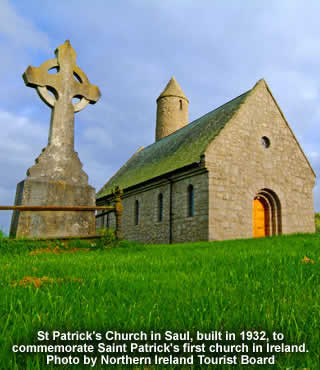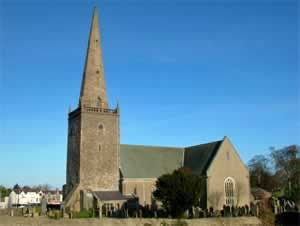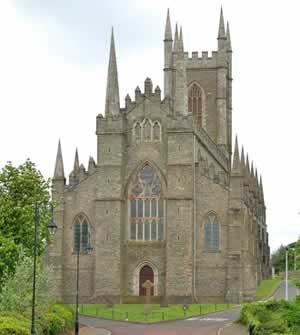St Patrick's Trail |
|
 |
|||
A recreation of Saint Patrick's legendary journey |
||||
|
||||
After being enslaved here as a child, Saint Patrick bravely returned to Irish shores to convert its pagans to Christianity. He walked many miles on his religious mission, making a strong impact wherever he went. Since the introduction of Saint Patrick's Trail, people have been able to follow in his historic footsteps. Alternatively, since the route is 62 miles long, you might prefer to drive in his footsteps. A set of roadside signs clearly mark the way. |
||||
The northern end of the trail meets the abbeys at Bangor and Movilla. These are part of Patrick's legacy; after he inspired their construction, many of the inhabitants made their own journeys to Europe. They set up monasteries themselves, continuing a chain reaction that saw Christianity take over the continent. |
||||
 Bangor Abbey. Photo in the Public Domain |
||||
That's the end of Saint Patrick's story, but just south of here you'll find the beginning. Beyond Strangford Lough is the small settlement of Saul, where the very first Irishman was converted. This led to a church: the first of hundreds that would be built in the following years. The achievement is commemorated here with a huge statue atop a nearby hill. |
||||
Fittingly, this was also the place where Patrick would say goodbye to Ireland. After a long, fulfilling life, he came to the nearby town of Downpatrick to die. It seems like this should be a sad place, but it's actually where the Saint's life is most fondly remembered. The Saint Patrick Centre is the only permanent exhibition in the world dedicated to his accommplishments. It tells his story using his very own words, taken from a written confession made near the end of his life. |
||||
The grave itself is at Down Cathedral. The building's huge towers and detailed stained glass windows do fitting tribute to their Saint. Not far from here are the ruins of St. Tassachs Church, where Patrick was given the last rites, and the Struell Wells, which can allegedly still heal people via a remnant of his power. |
||||
 Down Cathedral. Photo Aubrey Dale |
||||
As you follow the trail west, you'll see both ancient monuments and strange miracles. There's the Kilnasaggart Stone, with its strange inscriptions, or Kilbroney Graveyard, where the well water can still cure eye and throat diseases. |
||||
|
||||
The end of the journey is at the ancient town of Armagh. The settlement has older links with Christianity than just about anywhere else in the country, and is the traditional seat of Ireland's Archbishops. There's not one, but two cathedrals - one for the Church of Ireland, and one for Catholicism. The former evolved from the very first church in the county, built by Patrick in 445AD. The latter wasn't erected until hundreds of years later. Construction was delayed severely by the Irish Famine, but it was finally completed in 1904. |
||||
Within easy walking distance is a museum called Saint Patrick's Trian. The name recalls a time when Armagh was divided into 3 distinct sections. Fittingly, the museum is also divided in three. The first section tells the story of Saint Patrick, using writings from the Book of Armagh. This ancient, 9th century document was treated with great importance in its day. It sheds new light on Patrick's life. The Trian's other exhibitions look at the city's history as a whole, and at Jonathan Swift's famous novel, Gulliver's Travels. |
||||
It's impossible to recreate Patrick's full journey, up mountains and across lakes on his way from slave to saint. Nevertheless, the trail offers a chance to get to know the man a little better, and to see first-hand the impact he left on the country. |
||||
|
||||
Down Cathedral is open daily, 9.30am to 4.30pm (2pm to 5pm on Sundays). Down Cathedral, Cathedral Office, English Street, Downpatrick, BT30 6AB. Tel: 028 4461 4922 |
||||
Saint Patrick Centre is open daily, 10am to 5pm (Sundays by request in low season). Entry costs around £6 for adults, £3 children. The Saint Patrick Centre, 53a Lower Market Street, Downpatrick, County Down, BT30 6LZ. Tel: 028 4461 9000 |
||||
Saul Church can be found by following the A25 from Downpatrick to Strangford. Turn right onto Mearne Road. At crossroads turn right following signpost for Saul Church. Tel: 028 4461 4922 |
||||
|
Pocket Britain is optimised for use on a smartphone or tablet with internet access. All content is subject to copyright. All reasonable methods have been used to ensure information supplied is accurate at the time of publication. However, it is advisable to check information before relying on it. Privacy Policy |